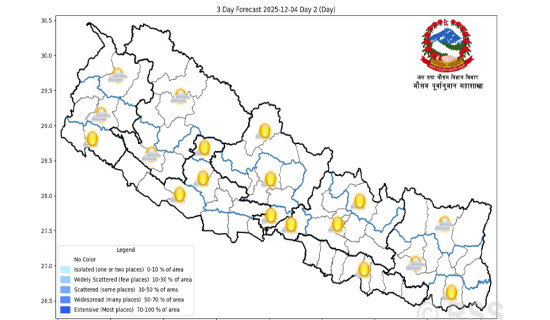- Thursday, 4 December 2025
Ways To Manage Mass Hysteria
Dr. Shyam P. Lohani
Recent reports of mass hysteria ranging from fainting of a staff at an operation threatre of a hospital and symptoms of seizures among school children have raised concern among the general public about the mass hysteria in Nepal. Such reports date back to the middle ages. Social contagion sometimes spreads positive emotions and behaviours. However, mass hysteria outcomes are generally negative.
Mass hysteria is also known as a conversion disorder, in which a person has physiological symptoms affecting the nervous system in the absence of a physical cause of illness, and is usually a reaction to psychological distress.
This phenomenon of similar symptoms often affects groups of people in which group members tend to exhibit symptoms such as fainting, seizures, etc.
Mass hysteria is related to the psychological phenomenon known as groupthink that may occur among people in a group. When a group forms a quick opinion that matches the group consensus rather than critically evaluating the information is a groupthink.
Symptoms
Mass hysteria tends to be characterised by symptoms that begin and end suddenly, relatively benign symptoms such as dizziness, headaches, muscle twitches, headaches, or stomachache.
These symptoms appear to occur among specific social groups sharing common characteristics. People affected by mass hysteria typically believe something specific has triggered their symptoms. They don’t have an underlying health condition that could prompt those symptoms. They also often do not behave in that way on a regular basis, and may share an extreme fear of an exaggerated or nonexistent threat.
There are commonly two types of mass hysteria, mass anxiety hysteria, and mass motor hysteria. Mass anxiety hysteria generally involves physical symptoms like chest pain, dizziness, headaches, and fainting.
Mass motor hysteria more often involves symptoms like shaking and twitching, partial paralysis, unstoppable laughing or crying, trance-like states, and altered speech patterns.
People may begin exhibiting symptoms especially after spending time together in a single location.
This phenomenon leads people to suspect that the symptoms are due to a contagious illness or environmental toxins.
The problem is that mass hysteria is very difficult to identify as it is happening. The cases of mass hysteria are apparent only through investigation retrospectively when testing or diagnosis revealed no underlying illness or cause.
Mass hysteria is related to the psychological phenomenon known as groupthink that may occur among people in a group.
When a group forms a quick opinion that matches the group consensus rather than critically evaluating the information is a groupthink. Groupthink is most commonly associated with business, politics, and policymaking. It is also often related to the psychology of collective phobias and mass hysteria.
Mass hysteria is also caused by extreme stress or trauma. People in stressful or overwhelming situations may mistakenly attribute feelings related to stress due to a physical or environmental cause.
Therefore, people in a collective trauma may begin to experience psychogenic symptoms. It is very difficult to provide a clear definition for mass hysteria or to characterise it with confidence as mass hysteria, or collective obsessional behaviour can take so many different forms. Instances of mass hysteria are seen among women. Researchers frequently argue that women are more socially bound to the group and usually respond with similar behaviour.
Mass hysteria is also associated with feelings of psychological distress. It is usually upsetting for people experiencing unexplained symptoms for which there are no underlying causes.
However, it is also essential not to dismiss symptoms as a sign of mass psychogenic illness without adequately ruling out exposure to environmental toxins.
Mass hysteria is not easy to diagnose. In most cases, incidences of mass hysteria are often treated as serious potential public health issues. The symptoms are investigated thoroughly, and people may be treated for unexplained and often unrelated symptoms.
Approaches
There are a few different tactics that might help people avoid getting involved in mass hysteria. The first approach is separation.
Separation, stress management techniques and psychotherapy are commonly used to help people affected by the condition.
Being separated from people who are exhibiting unusual or unexplained symptoms might help reduce the impact on others.
Adopting stress management strategies such as deep breathing, meditation, visualisation, or progressive muscle relaxation might help people who are distressed by the unexplained symptoms that they or others are experiencing.
Moreover, if mass hysteria affects anyone in terms of health or behaviour, having an appointment with a psychiatrist or therapist may be helpful. They help people cope with stressful situations.
Therapists utilise psychological approaches such as cognitive behavioural therapy that help reduce negative or anxious thoughts that contribute to mass hysteria.
Mass hysteria incidences have decreased substantially nowadays. However, such are still reported from time to time in many different settings such as schools.
It is important to remember that it is most often noticed through mass media usually in retrospect. Moreover, it is usually essential to rule out other illnesses and or exposure to environmental toxins.
It is also important that people get the diagnosis and appropriate treatment that they need in mass hysteria as well as exposure to other toxins. The recent trend of hiring nurses in a school is a positive step in reducing mass hysteria incidences.
However, there lacks training needed to deal with such incidences.
(Dr. Lohani is the clinical director at the Nepal Drug and Poison Information Centre. lohanis@gmail.com)
















